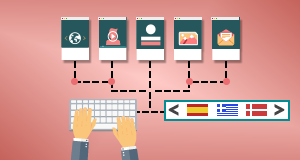The year 2011 was a good year for search engine marketing. As content became the king, some real impressive search engine optimized websites were developed. Many small and big players around the globe also poured into the domain of search engine marketing. Then in August 2011, the search engine giant Google came up with a new algorithm update and rolled out Panda internationally. This proved to be quite a challenge for websites that had a .com extension with either a sub domain or subdirectory structure. The problem was naturally more intense for companies that had presence in more than one country.
Multilingual and multi-country websites have similar content or translated similar content with perhaps some variations in terms of currency signs and title tags. So the combination of duplicate content and a directory/sub directory structure caused websites to get stuck in the Panda filter.
Google rolled out a solution for the problem that multiple language sites started facing due to Panda filter. This key was in the form of “hreflang” and “canonical” tags. This is Google’s way of telling site owners that they should use a regional subtag in their head tag for the website URL. This will help Google search crawlers to figure out the nature of content on each page and its relevance to a search performed. With these tags on websites, Google will comprehend that content on the site is truly intended for that region.
So, how do the hreflang and canonical tags help?
Hreflang tag
The hreflang attribute (hreflang: rel=”alternate” hreflang=”x”) is very helpful for website owners in different parts of the world who need content translated in native languages to target a particular region. It can be easily used for multilingual websites using substantially the same content on all web pages with some differences in spellings – for instance pages in English for Canada, USA and Australia.
Hreflang can also be used by multiregional websites using fully translated content or substantially monolingual content that targets different regions – pages in English, French, German, Spanish, and other languages.
To use the hreflang tag for multiple language versions of a website, each language must use rel=”alternate” hreflang=”x”. So, a page in German needs to have a rel=”alternate” hreflang=”x” link to the English and Spanish version and the English and Spanish version must include a link pointing to the German site.
Google has expanded its support of the rel=”alternate” hreflang link element to take care of content that is translated or offered for more than one geographic region. The hreflang attribute mentions the language, optionally the country, and URLs of equivalent content. By stating these alternate URLs, Google’s goal is to be able to consolidate signals for such web pages, and to serve the appropriate URL to users in search. Alternative URLs may be on the same website or on another domain.
Canonical tag
The multilingual canonical tag (rel=”canonical”) tells Google that a certain URL is the preferred location and the most significant translated version of the content of the primary or general URL.
So multilingual canonical tag:
- Is used in tandem with hreflang
- May be used when web pages have the same content in same language but target multiple countries
- Designate the translation of content that gets indexed and returned to users
With canonical tag on web pages, when users enter content into search results, they are likely to see the URL that has relevant content in their preferred language. In other words, Google will use “canonical” signal to focus on preferred version of web pages in each search, while displaying the local URLs to users where appropriate. To quote an example, you can use the tag if you have the same product page in Spanish, but want to target it separately to users searching on the Google properties for Spain, United Kingdom, and Germany.
To explain how the tags would work, here is an illustration for a hypothetical site abc.com
http://www.abc.com/ – contains the general homepage of a website, in Spanish
http://es-es.abc.com/ – is the version for users in Spain, in Spanish
http://es-uk.abc.com/ – is the version for users in United Kingdom, in Spanish
http://en.abc.com/ – is the generic English language version
For all of these pages, the website owner can use the following markup to specify language and optionally the region:
<link rel=”alternate” hreflang=”es” href=”http://www.abc.com/” />
<link rel=”alternate” hreflang=”es-ES” href=”http://es-es.abc.com/” />
<link rel=”alternate” hreflang=”es-UK” href=”http://es-uk.abc.com/” />
<link rel=”alternate” hreflang=”en” href=”http://en.abc.com/” />
When a regional sub tag is specified, Google assumes that the website owner wants to target that region. Website owners need to remember that all of these annotations are to be used on a per-URL basis. They need to use the specific URL, not the homepage, for both of these link elements.
You can employ:
- Hreflang tags to segregate same language, different content or different languages on different URLs
- Canonical tags to bring together same language and same content under one URL
While canonical acknowledges that this is the same content, the hreflang tag identifies which URL should be displayed in different sets of results.
And, canonical + hreflang = same content + different URL
Google understands that the content is the same, but displays the correct URL as per the Google domain search. The use of hreflang and canonical tags applies to local domains as well as dot coms, though the examples stated by Google are based on dot coms. The canonical and hreflang tags do not have any direct impact on ranking – canonicals do not share the link equity of the domestic market with the new markets targeted.
The obvious benefits of hreflang:
- It helps Google to comprehend your site better and know that pages are related to each other.
- It helps Google discover new URLs that could be the ones that it missed before in searches.
- It creates more targeted URL for searchers: Different users can see a suitable, localized URL.
So start using the hreflang tag – there are no reasons to be scared!
Kristjan Mar Hauksson
Latest posts by Kristjan Mar Hauksson (see all)
- The rising need for linguistic adaptation - September 13, 2012
- International companies should embrace the hreflang tag - April 11, 2012
- Do you know what consumers expect from your brands? - November 2, 2011






